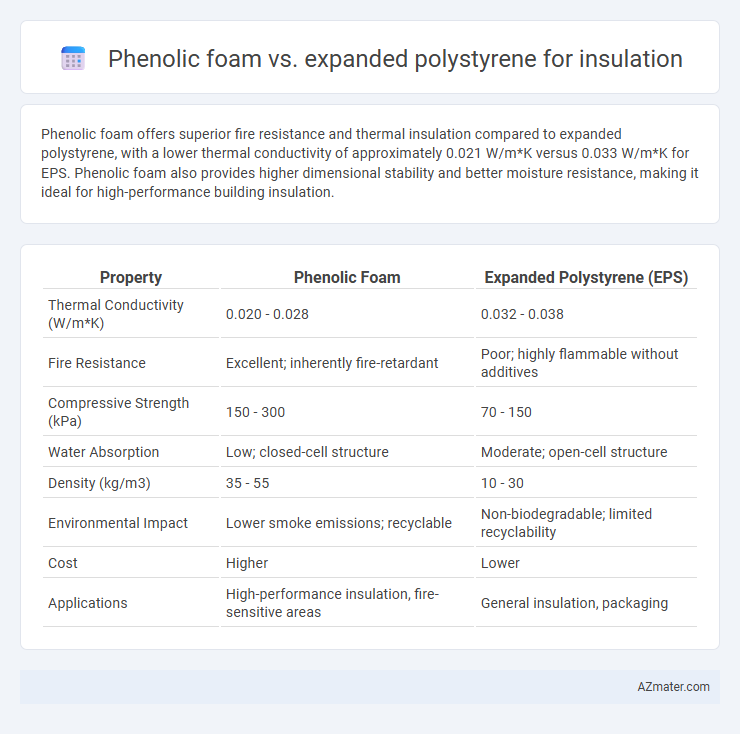Phenolic foam offers superior fire resistance and thermal insulation compared to expanded polystyrene, with a lower thermal conductivity of approximately 0.021 W/m*K versus 0.033 W/m*K for EPS. Phenolic foam also provides higher dimensional stability and better moisture resistance, making it ideal for high-performance building insulation.
Table of Comparison
| Property | Phenolic Foam | Expanded Polystyrene (EPS) |
|---|---|---|
| Thermal Conductivity (W/m*K) | 0.020 - 0.028 | 0.032 - 0.038 |
| Fire Resistance | Excellent; inherently fire-retardant | Poor; highly flammable without additives |
| Compressive Strength (kPa) | 150 - 300 | 70 - 150 |
| Water Absorption | Low; closed-cell structure | Moderate; open-cell structure |
| Density (kg/m3) | 35 - 55 | 10 - 30 |
| Environmental Impact | Lower smoke emissions; recyclable | Non-biodegradable; limited recyclability |
| Cost | Higher | Lower |
| Applications | High-performance insulation, fire-sensitive areas | General insulation, packaging |
Introduction to Insulation Materials
Phenolic foam offers superior thermal insulation with low thermal conductivity values around 0.020 W/m*K, making it highly efficient for building envelopes compared to expanded polystyrene (EPS), which typically has values near 0.035 W/m*K. Phenolic foam also provides excellent fire resistance, achieving Class 1 or Class A fire ratings, while EPS requires additional fire retardants to meet safety standards. Both materials are lightweight and moisture-resistant, but phenolic foam's closed-cell structure enhances its durability and insulation performance in harsh environmental conditions.
Overview of Phenolic Foam
Phenolic foam is a high-performance insulation material known for its superior thermal resistance, low smoke emission, and excellent fire retardant properties compared to expanded polystyrene (EPS). It features a closed-cell structure that provides exceptional moisture resistance and rigidity, making it ideal for applications requiring long-term durability and energy efficiency. Phenolic foam's higher R-value per inch improves insulation effectiveness, reducing energy consumption in both residential and commercial buildings.
Overview of Expanded Polystyrene (EPS)
Expanded Polystyrene (EPS) is a lightweight, rigid foam insulation material composed of closed-cell beads that provide excellent thermal resistance and moisture resistance, commonly used in building construction. EPS offers a high R-value per inch, typically around 3.6 to 4.2, making it effective for reducing heat transfer while maintaining structural stability. Its cost-effectiveness, ease of installation, and resistance to mold and rot make EPS a popular choice for wall insulation, roofs, and foundation applications.
Thermal Performance Comparison
Phenolic foam offers superior thermal performance compared to expanded polystyrene (EPS) due to its lower thermal conductivity, typically around 0.020 W/m*K versus EPS's 0.030-0.040 W/m*K. This results in better insulation efficiency, allowing phenolic foam to provide higher R-values per inch, making it more effective for energy-saving applications. Phenolic foam's closed-cell structure also enhances its resistance to heat transfer, outperforming EPS in maintaining consistent indoor temperatures.
Fire Resistance and Safety
Phenolic foam offers superior fire resistance compared to expanded polystyrene (EPS), characterized by a higher limiting oxygen index (LOI) typically above 28%, which makes it self-extinguishing and less prone to flame spread. EPS, with an LOI near 18%, is more flammable and produces toxic smoke during combustion, posing greater safety risks in building insulation applications. Fire safety codes often favor phenolic foam for environments requiring enhanced fire retardancy and reduced smoke emission, making it a safer choice in critical insulation projects.
Moisture Resistance Capabilities
Phenolic foam offers superior moisture resistance compared to expanded polystyrene (EPS), with a closed-cell structure that significantly limits water absorption and vapor permeability. EPS tends to absorb more moisture over time, reducing its thermal insulation effectiveness and potentially leading to mold growth. Phenolic foam's enhanced moisture resistance ensures long-term durability and insulation performance in high-humidity or wet environments.
Environmental Impact and Sustainability
Phenolic foam offers superior thermal insulation with a lower global warming potential (GWP) and reduced smoke toxicity compared to expanded polystyrene (EPS), making it a more sustainable choice for eco-conscious construction. EPS, while widely used for its recyclability and low cost, relies on petroleum-based feedstocks and often involves toxic flame retardants that pose environmental concerns during production and disposal. Phenolic foam's enhanced fire resistance and lower environmental footprint position it as a preferable option for reducing building emissions and advancing sustainable insulation practices.
Cost Analysis and Economic Considerations
Phenolic foam typically costs more per cubic meter than expanded polystyrene (EPS) due to its superior fire resistance and higher R-value, making it a premium choice for insulation projects where performance and safety are critical. EPS offers a lower upfront cost and wide availability, which appeals to budget-conscious construction sectors, but may incur higher lifecycle costs due to lower thermal efficiency and potential fire treatment expenses. Evaluating long-term economic benefits involves comparing initial investment against energy savings, maintenance, and fire mitigation costs, where phenolic foam often provides better value despite its higher price.
Installation and Application Differences
Phenolic foam offers superior fire resistance and higher R-values per inch compared to Expanded Polystyrene (EPS), making it ideal for complex or high-performance insulation projects, especially in commercial and industrial applications. EPS is easier to cut and install on-site due to its lightweight and rigid board form, suited for large surface areas like walls and roofs with simpler installation requirements. Phenolic foam requires careful handling to avoid damage to its brittle structure during installation, while EPS tolerates some compression and is often used where moisture resistance and cost-effectiveness are prioritized.
Best Use Cases and Recommendations
Phenolic foam offers superior fire resistance and higher thermal insulation performance, making it ideal for commercial buildings, industrial applications, and areas requiring stringent fire safety standards. Expanded polystyrene (EPS) excels in lightweight construction, moisture resistance, and cost-effectiveness, making it suitable for residential insulation, packaging, and under-slab applications. Choose phenolic foam when prioritizing fire safety and thermal efficiency, while EPS is recommended for budget-conscious projects with moderate insulation needs and exposure to moisture.

Infographic: Phenolic foam vs Expanded polystyrene for Insulation
 azmater.com
azmater.com